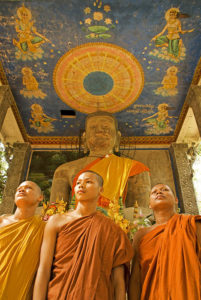
Young Buddhist monks with modern Buddha figure in temple near Bayon Temple. Photo by Dennis Cox/WorldViews
Here’s Part II of contributing writer Robert Waite’s recent journey to Siem Reap, Cambodia — home to the vast ruins of temple Angkor Wat, and much more. (If you missed Part I focusing on Angkor Wat, read it here.)
Here, Bob tours another huge temple complex complete with strangler trees, takes in a surprisingly good local circus, tangles with an oxcart, and takes a boat ride on a lake mostly devoid of water — all recounted with Bob’s deft descriptions and appropriately dry wit.
By Robert Waite
Siem Reap, Cambodia –
You come to Siem Reap for Angkor Wat, but you’d be wise to stay on and take in other area attractions. First and foremost there is Angkor Thom, another huge complex, one that served as the last and most enduring capital of the Khmer Empire.
Built in the late 12th century, the massive complex was constructed during the reign of King Jayavarman VII using elements of both Buddhist and Hindu architectural styles.
If you are trying to visit both Angkor Wat and Angkor Thom in the same day – which we foolishly did – be sure to take a break in between. There are a number of tree-shaded restaurants nearby serving local food (and a few even have enclosed, air conditioned dining areas).
That’s tip #1. Tip #2 is that if tourism traffic is particularly heavy, enter from the North Gate, not the South, which faces towards Angkor Wat.
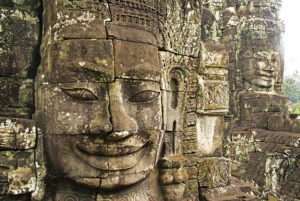
Stone face of Boddhisattva on Bayon Temple. Photo by Dennis Cox/WorldViews
We were told it is typically far less busy – and there are folks around who will give you a lift in a buggy-like conveyance to get you there for a small fee.
As things were not too busy, we entered via the South Gate.
“Great City”
Again, as with Angkor Wat, the scale of Angkor Thom is a bit overwhelming at first. The name literally translates as “Great City.” After the initial shock passes, you might next experience a sense of déjà vu, as some of the settings look like places you’ve seen before — perhaps in a movie.
And, if you’ve seen the film “Lara Craft: Tomb Raider,” you’d be right. Segments were shot here using a number of temples as backdrops, including Ta Prohm, which has narrow passageways and nooks and crannies.
While not exactly a tomb, it’s not a place where you’d want to meet up with a snake (and for those hoping to meet up with Angelina Jolie, I can personally attest she is not there).
As you wander about, one of the most striking things you notice, in addition to the architectural design and elaborate carvings and bas-relief work, are the many trees and tree roots penetrating the structures.
It is a bit of a conceit to say that Western explorers “discovered” Angkor Thom in the 19th century. As with Tikal in Guatemala, the locals did know the ruins were there – it’s just that they no longer had any real use or need for them.
Big Dig
But it’s true that Western explorers and archaeologists – often French – did find things almost completely overgrown. In most cases, trees, plants and centuries of debris were successfully cleared away.
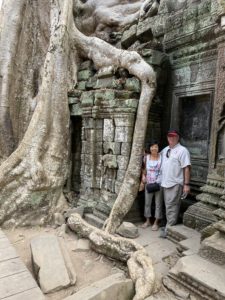
The author and wife pose by a tree strangling the temple.
But some of the larger trees, in particular, were so intertwined with a temple, from the very top even to its base, that attempting to remove them would have been akin to taking a scalpel to an inoperative tumor. So they were left in place.
This marriage of arbor and antiquity actually makes for some fabulous photo opportunities, as the roots create interesting, sculpture-like shapes as they follow the contours of the structures or disappear and reappear through openings.
The Bayon Temple is the centerpiece of the Angkor Thom complex. It is large and imposing, featuring 54 towers decorated with over 200 smiling faces of Avolokitesvara, a Buddhist Bodhisattva.
Bodhisattva is a person on the path to Buddhahood and Avolokitesvara is said to represent compassion. After hours of walking, a little compassion was welcomed by us all.
But there was still more to see, including the Royal Enclosure, the Elephant Terrace and the Terrace of the Leper King – all unique and worthwhile, but eventually the terraces and temples begin to blur together.
Flagging Energy
It was at this point, at the end of our Angkor Wat/Angkor Thom trekking, that our guide, Mr. Narin, a gentleman of seemingly boundless energy, reminded us that we had earlier agreed to attend a circus that evening “if I can get you tickets.”
“I have good news,” he now said with a broad grin. “We have tickets!”
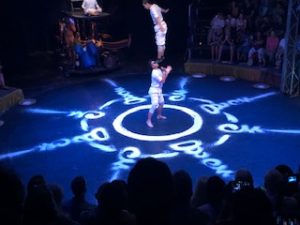
The Phare Circus turned out to be a delight. Photo by Robert Waite.
Our party of six exchanged furtive glances with one another that did not fully match Mr. Narin’s burst of glee. I, for one, had been entertaining visions of the hotel pool – and a vodka tonic.
But, after a quick dinner at a restaurant across the river from our hotel, we rallied and were soon off to see Phare: The Cambodian Circus.
In Part I of this series I wrote about the danger of having too high expectations when traveling: When it came to Phare, I had no expectations at all.
But, at the risk of ruining things for future Cambodian circus-goers, the evening was an unqualified delight. Performed in the round in a relatively small tent-covered space, the troupe follows a storyline that mirrors life in Cambodia today – the tug on the youth of the country between tradition and the headlong rush towards consumerism and modernity.
Artistic Flair
While this may sound a bit too serious, I should quickly point out that it is done with artistic flair, including an opening incorporating stunning dance and the use of rice to create elaborate designs on the stage floor; traditional Khmer dancing; and some of the best high flying acrobatics you’ll find this side of Cirque du Soleil.
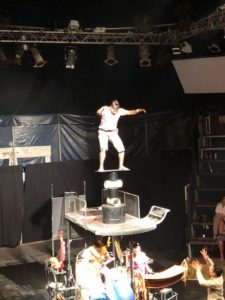
Acrobats at the Phare Circus. Photo by Robert Waite.
What made it all the more enjoyable was learning that Phare operates as a charity, providing some 1,200 disadvantaged young people with vocational training.
This is definitely a must-see and worth including on your itinerary.
The next morning, after breakfast, we headed out into the countryside for a whole different kind of experience.
Now, for those familiar with Cambodian history, “heading out into the countryside” can have an ominous ring. The Khmer Rouge, a particularly nasty brand of communist rebels, seized power in 1975. As part of their effort to create a “new” Cambodia they evacuated the cities, sending millions out into the countryside for “re-education.” Hundreds of thousands were executed. These were the “killing fields” documented in books and film.
Those horrors are not forgotten – there are museums and memorials – but today the Cambodian countryside is tranquil and its inhabitants go on with life with a mix of the traditional and modern, not dissimilar to the theme of the circus performance.
The Oxcart Incident
We visited Chreav Village, in a largely agricultural area outside Siem Reap, piling onto two-wheeled flat-bed carts — pulled, sometimes reluctantly, by oxen. Comfortable? Let’s just say I will never again complain about the lack of lumbar support in my wife’s Ford Fiesta. But it certainly did feel like a genuine experience.
While on tour with our bovine locomotion we stopped to look at an organic vegetable farm to speak with the farmer and observe his irrigation techniques (as January was the dry season).
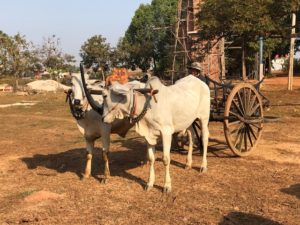
The oxcart, sans lumbar support. Photo by Robert Waite.
We also had an opportunity to see typically rural housing along the way. On the route back, we also experienced a near oxcart disaster – one of the carts took too tight a turn at a dusty corner, catching a store’s roof support pole between the cart’s wheel and axle. It had all the making of a Farmers Insurance “We Covered That, Too” ad – but, fortunately, the oxen were coaxed to back up.
Another highlight of the area is Tonle Sap Lake, the largest freshwater lake in Southeast Asia. The lake’s waters exit to the southeast into the Tonie Sap River, which eventually meet up with the Mekong River in Cambodia’s capital, Phnom Penh.
We approached Tonle Sap Lake from its north side, closest to Siem Rep, and secured one of the hundreds of available narrow, shallow-draft boats to make our way down a tributary to the lake itself.
High and Dry
As mentioned, January is the dry season. You don’t really understand what that means until you approach the so-called “floating villages” that the area is famed for.
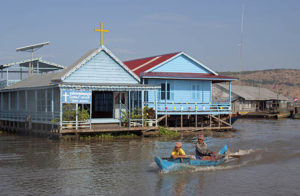
Tonle Sap lake’s floating village during wet season. Photo by Dennis Cox/World Views.
As you round a bend in the extremely shallow stream, upwards to the right, held up on pilings 25 to 35 feet (8-10 meters) in the air, are homes, schools, stores – all manner of structures needed for village life.
In the rainy season, the water level is such that you can step from a boat up a short ladder and be home. Now, you disembark and make your way up a steep embankment and find yourself in a bone-dry village.
Further on, out onto the lake, you can visit a truly floating wooden structure that serves as a fishing base, a restaurant – and also as a kind of display area for captured crocodiles. We did not ask to see a menu.
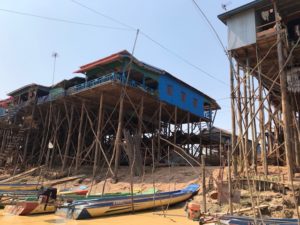
Tonle Sap floating village in dry season. Photo by Robert Waite.
Seeing Tonle Sap Lake and the floating villages during the dry season reminded me of a visit we previously made to Victoria Falls in Zimbabwe, also in the dry season. The falls were flowing at a small fraction of their rainy season volume. Our guide, putting the best spin on it, said, “But at least you can see down into the gorge. When the falls are at full force, all you can see is mist.”
My day job is teaching public relations – the fellow deserved an “A.”
And seeing the floating villages high and dry did provide a unique perspective. Only with the water missing could you truly appreciate just how high things had to be to stay dry.
This was a case where the proverbial glass was well less than half empty, but the experience was more than half full.
If You Go
Travel arrangements were made by JBC Travel, Ottawa, Canada.
Accommodation in Siem Reap was at the Treeline Urban Resort, which has an enticing outdoor infinity pool, an even more enticing outdoor bar and also serves a very good breakfast.
Information regarding Phare: The Cambodian Circus can be found here – https://pharecircus.org/ There are three types of seating with three different prices – Section A, $38; Section B, $28; Section C, $18. Section C may have some obstruction; Section A is towards the front. My recommendation is Section B – you are higher up and that affords a better vantage point. And you can always donate the $10 difference to the circus, which is a charity.
Author Bio: Robert Waite has written on travel for almost 50 years. A former Pacific News Service correspondent, he is a professor at Seneca College in Toronto and Managing Partner at Waite + Co., a communications consulting firm with offices in Boston, Ottawa and Toronto.












2 Responses to High and Dry In Siem Reap